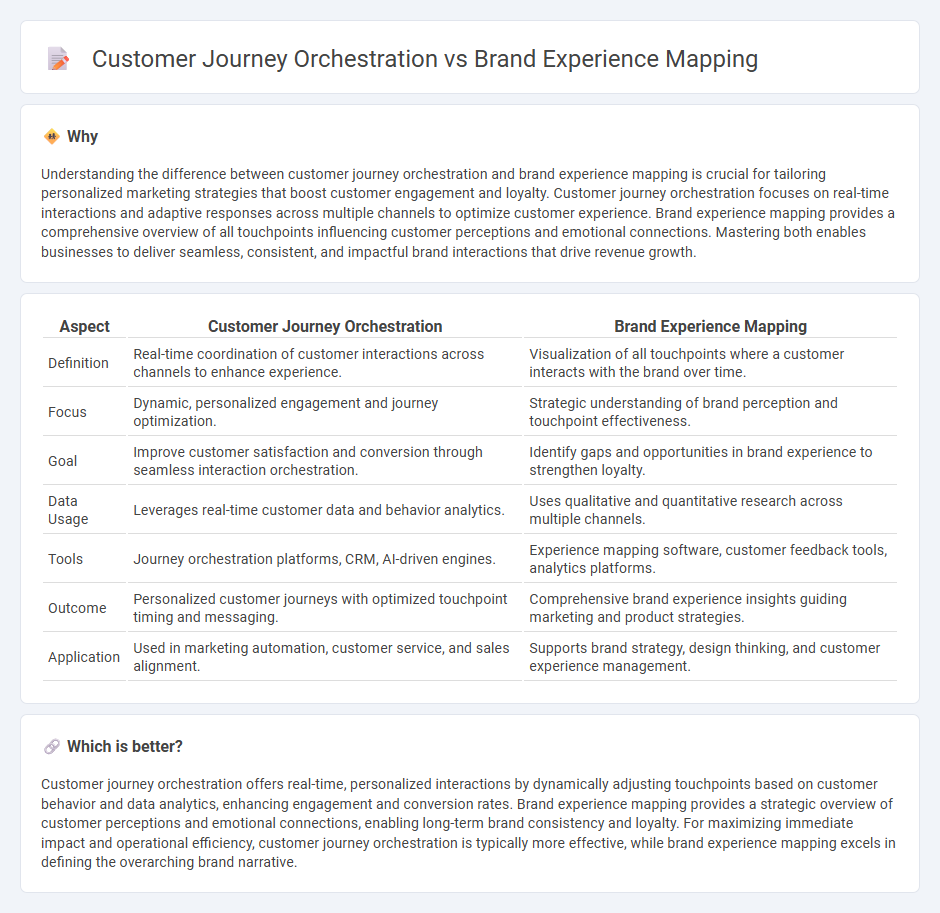
Customer journey orchestration focuses on actively managing and optimizing every interaction a customer has with a brand across multiple channels, ensuring seamless, personalized experiences that drive engagement and loyalty. Brand experience mapping, on the other hand, visualizes the emotional and cognitive touchpoints consumers encounter throughout their relationship with a brand, helping identify opportunities to deepen brand connection and consistency. Explore how integrating customer journey orchestration with brand experience mapping can elevate your customer engagement and brand strategy.
Why it is important
Understanding the difference between customer journey orchestration and brand experience mapping is crucial for tailoring personalized marketing strategies that boost customer engagement and loyalty. Customer journey orchestration focuses on real-time interactions and adaptive responses across multiple channels to optimize customer experience. Brand experience mapping provides a comprehensive overview of all touchpoints influencing customer perceptions and emotional connections. Mastering both enables businesses to deliver seamless, consistent, and impactful brand interactions that drive revenue growth.
Comparison Table
| Aspect | Customer Journey Orchestration | Brand Experience Mapping |
|---|---|---|
| Definition | Real-time coordination of customer interactions across channels to enhance experience. | Visualization of all touchpoints where a customer interacts with the brand over time. |
| Focus | Dynamic, personalized engagement and journey optimization. | Strategic understanding of brand perception and touchpoint effectiveness. |
| Goal | Improve customer satisfaction and conversion through seamless interaction orchestration. | Identify gaps and opportunities in brand experience to strengthen loyalty. |
| Data Usage | Leverages real-time customer data and behavior analytics. | Uses qualitative and quantitative research across multiple channels. |
| Tools | Journey orchestration platforms, CRM, AI-driven engines. | Experience mapping software, customer feedback tools, analytics platforms. |
| Outcome | Personalized customer journeys with optimized touchpoint timing and messaging. | Comprehensive brand experience insights guiding marketing and product strategies. |
| Application | Used in marketing automation, customer service, and sales alignment. | Supports brand strategy, design thinking, and customer experience management. |
Which is better?
Customer journey orchestration offers real-time, personalized interactions by dynamically adjusting touchpoints based on customer behavior and data analytics, enhancing engagement and conversion rates. Brand experience mapping provides a strategic overview of customer perceptions and emotional connections, enabling long-term brand consistency and loyalty. For maximizing immediate impact and operational efficiency, customer journey orchestration is typically more effective, while brand experience mapping excels in defining the overarching brand narrative.
Connection
Customer journey orchestration and brand experience mapping are interconnected through their focus on understanding and optimizing every touchpoint a customer has with a brand. By aligning the insights from brand experience mapping with the strategic execution of journey orchestration, businesses create seamless, personalized interactions that enhance customer satisfaction and loyalty. This integrated approach enables consultants to design cohesive experiences that drive engagement and measurable business outcomes.
Key Terms
Touchpoints
Brand experience mapping identifies and analyzes key touchpoints where customers interact with a brand, highlighting emotional and sensory elements to enhance brand perception. Customer journey orchestration strategically manages these touchpoints in real-time using data-driven insights to deliver seamless, personalized experiences across channels. Explore how integrating both approaches can maximize customer engagement and satisfaction.
Personalization
Brand experience mapping visually represents customer interactions and emotions to identify personalization opportunities at each touchpoint, enhancing brand-consumer connections. Customer journey orchestration uses real-time data and automation to deliver personalized experiences dynamically across multiple channels, ensuring consistent and relevant messaging. Explore how integrating both strategies can elevate your personalization efforts for deeper customer engagement.
Engagement
Brand experience mapping visualizes customer interactions across touchpoints, identifying emotional highs and engagement drivers to enhance brand perception. Customer journey orchestration actively manages and personalizes these interactions in real-time, optimizing engagement by delivering contextually relevant messages and experiences. Discover how mastering both strategies can elevate customer engagement to new levels.
Source and External Links
5 Steps to Create a Brand Experience Map - Wavetec - A brand experience map visually outlines the customer journey with a brand, highlighting key touchpoints, emotional highs and lows, and pain points to help businesses improve customer satisfaction and loyalty through a smoother, more engaging experience.
Customer Experience Mapping: What Is It And How To Do It? - Customer experience mapping involves understanding the tasks and actions customers take in their engagement with a product or service, allowing startups to identify where to focus improvements and deliver a consistent user experience.
The Guide to Experience Map: Elements and Methods - Nudge - Experience mapping is a UX method that reveals all user interactions with a brand, identifies frustrations and delights, fosters team collaboration, and drives continuous improvement to create seamless, satisfying customer experiences that boost business outcomes.
 dowidth.com
dowidth.com